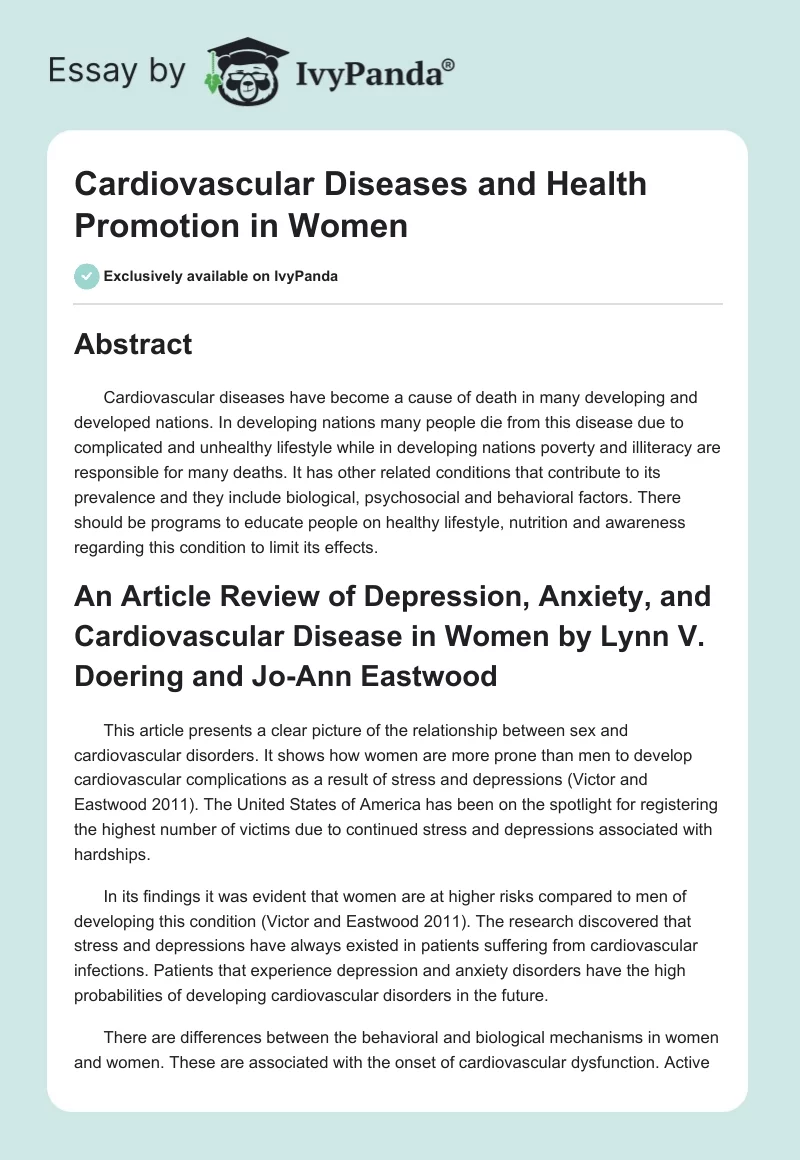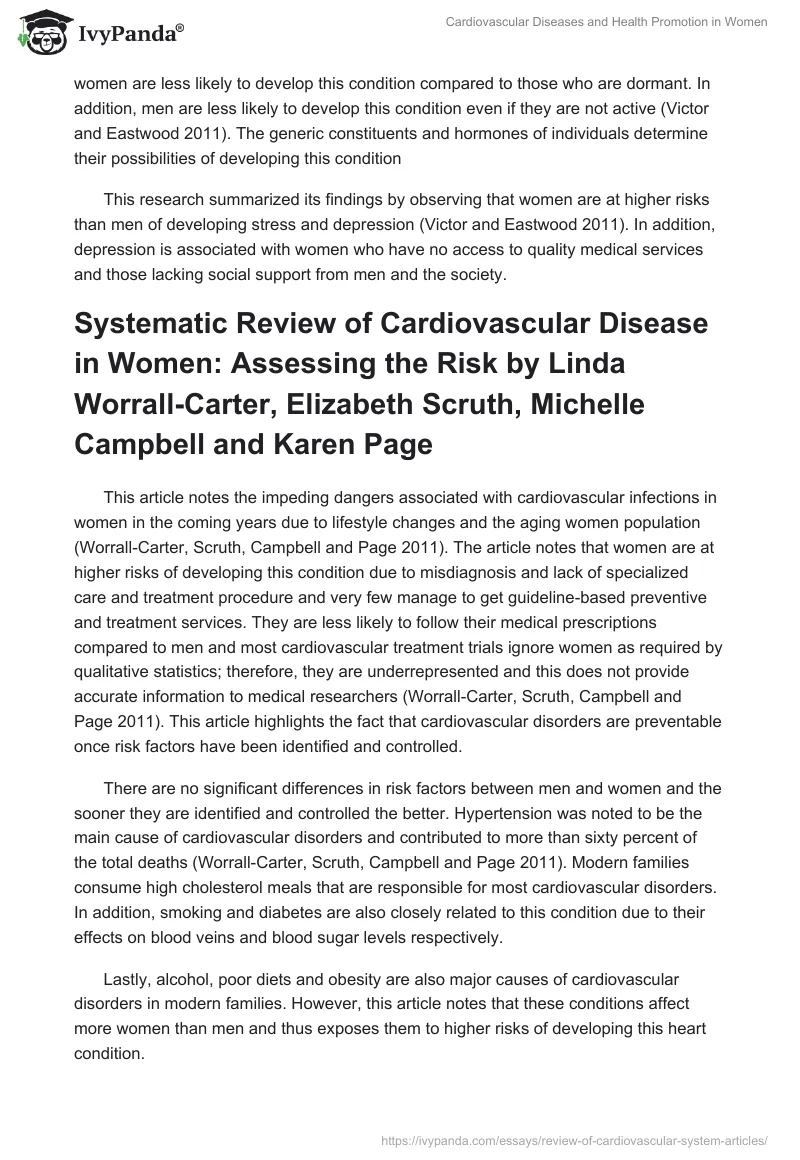Abstract
Cardiovascular diseases have become a cause of death in many developing and developed nations. In developing nations many people die from this disease due to complicated and unhealthy lifestyle while in developing nations poverty and illiteracy are responsible for many deaths. It has other related conditions that contribute to its prevalence and they include biological, psychosocial and behavioral factors. There should be programs to educate people on healthy lifestyle, nutrition and awareness regarding this condition to limit its effects.
An Article Review of Depression, Anxiety, and Cardiovascular Disease in Women by Lynn V. Doering and Jo-Ann Eastwood
This article presents a clear picture of the relationship between sex and cardiovascular disorders. It shows how women are more prone than men to develop cardiovascular complications as a result of stress and depressions (Victor and Eastwood 2011). The United States of America has been on the spotlight for registering the highest number of victims due to continued stress and depressions associated with hardships.
In its findings it was evident that women are at higher risks compared to men of developing this condition (Victor and Eastwood 2011). The research discovered that stress and depressions have always existed in patients suffering from cardiovascular infections. Patients that experience depression and anxiety disorders have the high probabilities of developing cardiovascular disorders in the future.
There are differences between the behavioral and biological mechanisms in women and women. These are associated with the onset of cardiovascular dysfunction. Active women are less likely to develop this condition compared to those who are dormant. In addition, men are less likely to develop this condition even if they are not active (Victor and Eastwood 2011). The generic constituents and hormones of individuals determine their possibilities of developing this condition
This research summarized its findings by observing that women are at higher risks than men of developing stress and depression (Victor and Eastwood 2011). In addition, depression is associated with women who have no access to quality medical services and those lacking social support from men and the society.
Systematic Review of Cardiovascular Disease in Women: Assessing the Risk by Linda Worrall-Carter, Elizabeth Scruth, Michelle Campbell and Karen Page
This article notes the impeding dangers associated with cardiovascular infections in women in the coming years due to lifestyle changes and the aging women population (Worrall-Carter, Scruth, Campbell and Page 2011). The article notes that women are at higher risks of developing this condition due to misdiagnosis and lack of specialized care and treatment procedure and very few manage to get guideline-based preventive and treatment services. They are less likely to follow their medical prescriptions compared to men and most cardiovascular treatment trials ignore women as required by qualitative statistics; therefore, they are underrepresented and this does not provide accurate information to medical researchers (Worrall-Carter, Scruth, Campbell and Page 2011). This article highlights the fact that cardiovascular disorders are preventable once risk factors have been identified and controlled.
There are no significant differences in risk factors between men and women and the sooner they are identified and controlled the better. Hypertension was noted to be the main cause of cardiovascular disorders and contributed to more than sixty percent of the total deaths (Worrall-Carter, Scruth, Campbell and Page 2011). Modern families consume high cholesterol meals that are responsible for most cardiovascular disorders. In addition, smoking and diabetes are also closely related to this condition due to their effects on blood veins and blood sugar levels respectively.
Lastly, alcohol, poor diets and obesity are also major causes of cardiovascular disorders in modern families. However, this article notes that these conditions affect more women than men and thus exposes them to higher risks of developing this heart condition.
Evaluation of a Cardiovascular Health Promotion Program offered to Low-Income Women in Korea by Kyung Ok Ham and Bong Jeong Kim
This program was carried out in South Korea to evaluate risk factors associated with cardiovascular infections among women aged forty years. South Korea is a developing nation and faces a lot of challenges in terms of economy and service provision (Ham and Jeong Kim 2011). Even though, there are many state owned medical facilities they are not enough and well equipped to handle all health matters satisfactorily.
This article summarizes the risk factors that lead to cardiovascular disorders as biological, behavioral or psychosocial. The article has identified poverty as the main cause of health complications in middle aged women. The paper has also identified other behavioral factors that are not easily controlled as the chief causes of health hazards.
The South Korean poverty index is high and this means most people cannot afford proper healthcare services, balanced diet and quality lifestyle. Most people suffer from lack of adequate basic needs and this exposes them to other health risks (Ham and Jeong Kim 2011). Women form the bulk of disenfranchised group in almost all world communities and this exposes them to other hazards.
Poverty is directly proportional to stress and depression and this means most women are stressed and easily develop cardiovascular disorders. However, women can be empowered through social and financial programs to reduce their risks of developing this condition (Ham and Jeong Kim 2011). This article highlights the gains made after introducing empowerment programs to enable poor women to manage their families and their lifestyle.
Even though, these programs were successful in managing the biological and psychosocial challenges associated with the disease, it was not successful in changing behavior (Ham and Jeong Kim 2011). Smoking and alcoholism were serious challenges facing this program and interfering with the implementation of other related activities.
Relationships between Cardiovascular Disease Risk Factors and Depressive Symptoms as Predictors of Cardiovascular Disease Events in Women Thomas Rutledge, Sarah E. Link and Delia Johnson
There were more women than men who admitted to having used antidepressants in the past. Majority of the middle aged women were still using antidepressants due to various reasons including marital stress, economic hardships and family hardships (Rutledge, Link and Johnson 2011). However, the younger and unmarried population recorder lower consumption rates and those who admitted it did it due to peer pressure, curiosity and academic strains.
There were several risk factors that contributed to the prevalence of cardiovascular diseases among the sample population used. These factors include lifestyle, biological and psychosocial aspects of human life. Diabetes was one chief cause of this condition and accounted for about 22% of the total population while the use of antidepressant accounted for 11%. Age was the greatest risk factor that contributed to a high rate of developing cardiovascular disease (Rutledge, Link and Johnson 2011). This is associated with activities like inactivity, inadequate health information, poor sanitation and a weak immune system.
Conclusion
These articles were about researches that examined the relationships between cardiovascular disorders and depressions, gender, age, poverty and literacy. They identified several risk factors that contribute to an increase in this disease. The use of antidepressants by most participants was a significant factor as to whether these people suffered stress or not.
References
Ham. K. O. and Bong Jeong Kim. (2011). Evaluation of a Cardiovascular Health Promotion Program offered to Low-Income Women in Korea. Boston: Wiley-Blackwell.
Rutledge, T., Sarah E. Link and Delia Johnson. (2011). Relationships between Cardiovascular Disease Risk Factors and Depressive Symptoms as Predictors of Cardiovascular Disease Events in Women. London: Routledge.
Victor, L. and Jo-Ann Eastwood. (2011). A Literature Review of Depression, Anxiety, and Cardiovascular Disease in Women. Boston: Wiley-Blackwell.
Worrall-Carter, L., Elizabeth Scruth, Michelle Campbell and Karen Page. (2011). Systematic Review of Cardiovascular Disease in Women: Assessing the Risk. Boston: Wiley-Blackwell.


